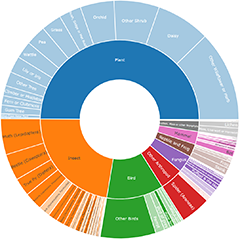Moths (Lepidoptera)
Useful references:
- CSIRO's Australian National Insect Collection (ANIC) - Australian Moths Online
- Don Herbison-Evans web pages:
In the notes provided about individual species, semi-technical terms are sometimes used. They are briely explained below.
Labial palpi. These are paired appendages extending from the lower part of the head, on either side of the proboscis. They provide important information about the family of the moth.
Parts of a moth’s wing:
Costa: The leading edge of the wing
Inner margin: The trailing edge of the wing
Termen: The outer margin of the wing, connecting the costa to the inner margin
Apex: The leading tip of the wing, where the costa and termen meet
Tornus: The trailing corner of the wing, where the termen and inner margin meet
Cilia. Long hairy scales along an edge of the wing
Announcements
Discussion
Chrysolarentia severata
Chrysolarentia severata
Oecophoridae (family)
Recent activity
Chrysolarentia severata at Freshwater Creek, VIC
Chrysolarentia severata at Freshwater Creek, VIC
Oecophoridae (family) at Freshwater Creek, VIC
Anachloris subochraria at Herne Hill, VIC
Heteroteucha occidua at Freshwater Creek, VIC
Heteroteucha occidua at Freshwater Creek, VIC
Heteroteucha occidua at Freshwater Creek, VIC
Oecophoridae (family) at Freshwater Creek, VIC
Top contributors
- kasiaaus 5.2K
- jb2602 2.7K
- WendyEM 1.9K
- PJH123 1.6K
- AlisonMilton 1.6K
- ConBoekel 1.5K
- Bron 1.2K
- Hejor1 1.2K
- SteveBorkowskis 1.1K
- GlennCocking 1K
Top moderators
- donhe 15.4K
- ibaird 13.5K
- GlennCocking 3.4K
- DianneClarke 1.3K
- MichaelMulvaney 604
- MichaelBedingfield 170
- JulieMorgan 161
- kasiaaus 102
- KimPullen 97
- jb2602 60















































































































